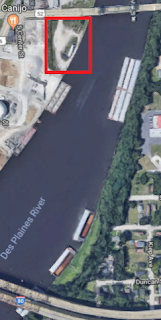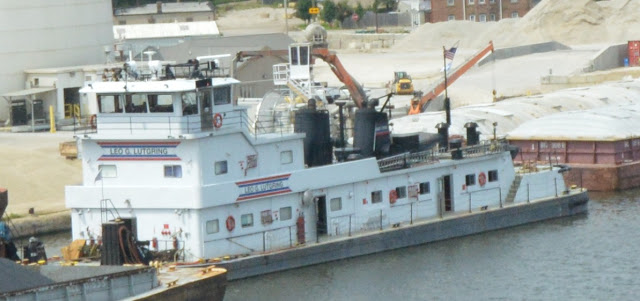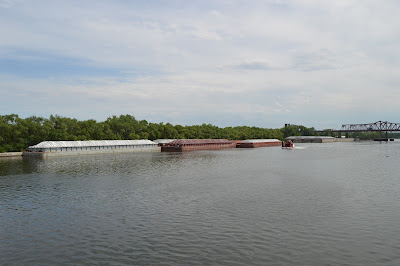 |
| Satellite |
Below is an example of several barges parked on the east side of the river. It looks like 11 barges are parked there. The bridges in the right background are for I-80. The blue handrail in the foreground is part of the US-6 Bridge.
 |
| 20170615 9215 |
 |
| Satellite |
In addition to a local pushboat that has a retractable pilothouse, we see a big pushboat.
 |
| 20150702 2251 |
 |
| 20150702 2252 |
Zooming in on the first photo, I could read the name of the pushboat --- Leo G. Lutgring. It is 160'x35' and built in 1978. It is a reminder that Alco, formerly a steam locomotive manufacturer, still makes diesels because it is a twin screw with 12-251F engines with 4370 hp. [TowBoatGallery] (Actually, I think Fairbanks-Morse bought that brand and makes the diesels. But since Google's blog search function broke April 3, 2018, I can't find my posting about Fairbanks-Morse making Alcos.)
 |
| Digitally Zoomed |
These videos confirm that the Leo G. Lutgring can handle a full 15-barge tow on the Mississippi River.
(new window)
This video makes it look like a triple-screw towboat. But it does have just two exhaust stacks. I wonder if the engines drive alternators and electric motors are used on the prop shafts. That would allow two engines to easily power three propellers.
(new window)
I've learned that disassembling and assembling large tows is called fleeting. Each of the local marine services such as Ozinga's Middle River Marine and Illinois Marine Towing have fleeting areas, including this Joliet area south of the US-6 Bridge. These fleeting areas are similar to local freight switch yards for railroads such as Eola and GM Yard. Specifically, they are big enough that they can hold a long tow/train and have enough area that the towboat/locomotive can store barges/cars while it sorts out what goes where along the river/track.
The analogy continues with big pushboats/road locomotives being used for long distance travel, and smaller pushboats/switching locomotives being used for the local movements. In the case of the Chicago area, local pushboats must have retractable pilothouses because, except for the South Branch Bridge, none of the movable bridges are operated for barge traffic. The barge traffic is expected to fit under the 16.5' clearance of the bridges. Since the level of the Chicago River, the Cal Sag Channel, and the CS&SC are controlled by locks, a powerhouse, and a gate structure; rain storms should not reduce the 16.5' clearance.
Continuing the analogy, fleeting/railyard capacity is used to store empty barges/cars until another customer needs one. And there may provide additional services such as cleaning and/or repairing barges/cars.
 |
| A retired professional brown water mariner from tugster |
Looking back through my Joliet visits, I found that I had seen the Leo G. Lutgring before. It was pushing this 11-barge tow that included a bow-steering pushboat upbound through Joliet.
 |
| 20150603 1961, Flickr: 6016 x 4000 |
(new window)
At the time I saw this tow, I wondered where this 3x3+2 tow was going because the canal is the width of four barges, but many places have two adjacent barges docked along the canal.
 |
| Satellite |
- Bulk, non-bulk, and break-bulk warehousing and stevedoring services- 70,000 square feet of indoor warehouse space- Temperature-controlled warehousing- 7 acres of outside storage- Electronic inventory system- Transloading from truck to barge and from barge to truckI learned that ACL owned Leo G. Lutgring because I saw the following in their moving banner on their home page.
 |
| ACBL |
 |
| Satellite |
 |
| Flickr: 6016 x 4000 |
I say bye-bye to the 11-barge tow and turn my attention back to fleeting.
 |
| David Webster posted, Apr 2021 That 3x3 tow in the Ozinga's Middle River Marine fleeting area looks rather large for the towboat tied to it. I see Ozinga has gotten larger towboats since I last checked out their roster (which I no longer can find). [With the two bigger towboats, Ozinga now does its own tows down the the Illinois River.] |
 |
| 20170608 9077 |
Note in the closeup that there is a shuttle pushboat next to the barge. I don't have enough resolution to read the name.
 |
| Digitally Zoomed |
 |
| 20170621 9330 |
3:10:11 It is almost easier to see the white plume than the boat itself down near the end of the third tier of barges.
3:10:39 The boat is really leaning into its turn.
 |
| Digitally Zoomed |
15:11:19 I recognize Alivia Faith as one of pushboats in Ozinga's Middle River Marine. So Ozinga and Illinois Marine Towing share this fleeting area. It looks like this pushboat always leans to port.
In the closeup above, I can see there is a deckhand at the base of the port knee. In this photo, I see that the captain is leaving the pilothouse...
3:12:02 ...to climb the starboard knee. I find it interesting that the crew member was wearing a life preserver, but the captain does not have one.
3:12:24 The captain is back in the pilothouse, so he evidently got on the knee, not because he was going to help tie up, but because he was just verifying that he positioned the pushboat at the middle of the barge. Since he did not get on the barge, that would explain why he didn't have a life preserver.
3:12:42 This next sequence of photos shows the pilothouse being raised. Note the pilothouse was retracted when it was running light because there was nothing to see over.
3:13:05
3:13:25 But even a loaded barge blocks the view of the pilothouse unless it is raised.
In the meantime, the deckhand has tied the pushboat to the barge and untied the barge from the other barges in the fleeting area because the barge is moving.
3:13:43
3:14:04 Between the pilothouse going up and the barge moving, there is enough action that I was probably thinking of switching to video.
3:14:15 But instead, I have found a photo viewer app/program that will display seconds in the timestamp. Even though there is a lot of action as far as pushboats go, the action is still slow as far as video action goes since we have become accustomed to skyscrapers being destroyed every few seconds by superheroes. Furthermore, it is much more effective digitally zooming a 6000x4000 photo.
3:14:46 I wonder if this is full height for the pilothouse because it would be hard to see over an empty barge with covers.
3:15:02 Note the unloading area at Ozinga is currently empty.
15:15:14 There is propwash behind only the starboard propeller. That is because the port propeller is in reverse. This is why pushboats have two engines and the two propellers are near the edges of the stern. By running the propellers in opposite directions, it allows them to twist the barge around.
 |
| Digitally Zoomed |
3:16:21 Here we can clearly see he is running the port propeller in reverse.
 |
| Digitally Zoomed |
3:16:30 Even at full power, the propwash is small compared to what we have seen in some photos of line-haul pushboats because the Alivia Faith is just 650hp.
3:18:47
3:19:34 I noticed a downbound tow is coming from the north. This creates a race --- will I see this barge docked at Ozinga's unloader before I have to get off the bridge because it is going to be raised for this downbound tow?
3:19;55
3:20:23 So they position the front of the barge at the dock first.
3:20:36 The other tow is getting closer. Also note on the left that they have just started loading a barge with grain. And the barge behind it has already been loaded. I've never seen a shuttle pushboat there. I wonder if they use the excavator to push (or pull) a barge as well as handle the covers.
3:22:07 The rear of the barge is swung over to the dock. (Does one talk about the bow and stern of a barge? I have not seen examples to read about handling individual barges.)
3:22:25
3:23:06 I saw the barge docked before I had to get off the bridge.
15:23:22 There is another downbound tow under the Cass Street Bridge.
 |
| Digitaly Zoomed |
3:24:04 I now have to get off the bridge. Both downbound tows look small. I wonder if they will be able to lock through the Brandon Lock at the same time. (We will see shortly that they are not going to the lock.)
(new window)
...that it is delivering its two barges to the fleeting area:
 |
| 3:30:16 |
I included the Ozinga barge that we had just seen moved to show that the pushboat is no longer attached to the barge and that they have removed some covers from the barge.
 |
| 3:31:19 |
 |
| 3:35:53 |
(new window)
Because the bridge goes up long before the tow has approached the bridge, it backs up traffic on US-6 as far as I could see.
With its fixed bridge, the Lemont Trader is obviously a line-haul pushboat. It is 90'x30' and 3200hp and has Cummins generators as well as QSK50 engines. I was not aware that Cummins made generators as well as diesel engines. That shows how big the market is for backup electricity and electric transmissions. I wonder whose motors are used on the propeller shafts. Since this was built in 1974, I also wonder if it uses DC instead of AC. [IMT-boat-position]
As I leave the bridge, traffic is still tied up. I used side streets to go south to checkout the Brandon Lock and Dam so that I could avoid that mess.
It is obvious that they will be assembling a 15-barge downbound tow for the Lemont Trader.
 |
| LMT Towing-Fleeting Southbound "Lemont Trader" Joliet Harbor with 15 barge tow |
 |
| Satellite |
 |
| Satellite |
(new window) You may want to mute this video. The captain that is making the video makes quite a few worried sounds. The first words spoken are at 4:35: "There she goes." And you don't want to hear the next words he says. (It doesn't go under.) I have no idea how they managed to tie the ropes to the hitching posts that were under water. The other towboat must have delivered the guy we see running into the second story door at 8:10.
While trying to find where a new port is supposed to be built in Cairo, IL, I noticed a couple of weird looking tows on the Ohio river. Zooming in revealed that the tows were being built by a fleeting operation. I wonder how they anchor those tows in the river while they are being built.
 |
| Satellite |
 |
| Satellite |
Two harbor tugs that do fleeting operations on the west bank of the Illinois river at Havana, IL.
 |
| Jack Tanner Towing posted River may be up, but we keep on going.... (Photo credit: Dave Huber) |
Note that the doors on the first floor are under water because the current has pushed the towboat so far under the barges. That is why they are watertight and why the crew should keep them shut. I've seen videos of twoboats sinking because the crew had not shut the doors.
 |
| 1:37 timelapse video @ 0:25 Training Day. Steersman Lessons |

































No comments:
Post a Comment